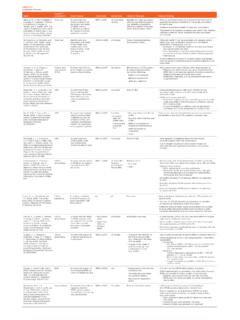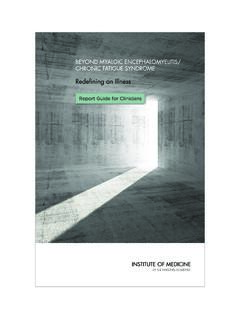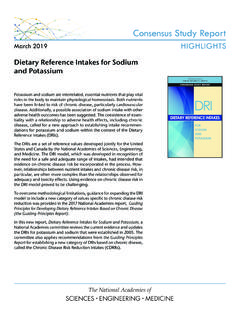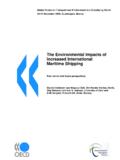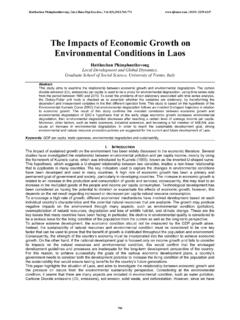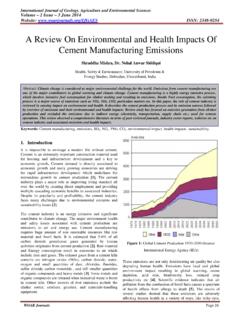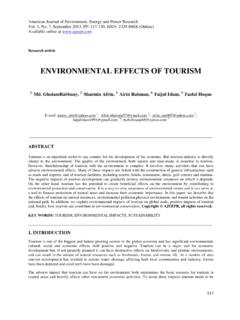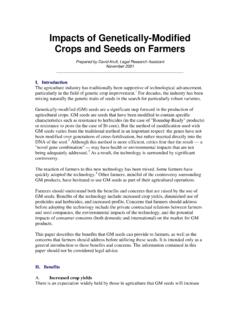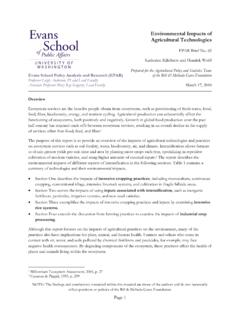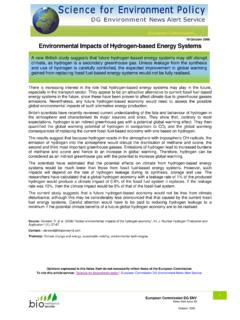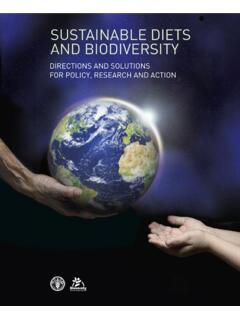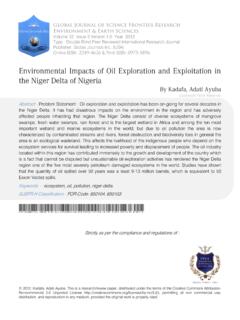Transcription of ECOLOGICAL IMPACTS OF CLIMATE - National Academies Press
1 Life on Earth is profoundly affected by the planet s CLIMATE . Animals, plants, and other living beings around the globe are moving, adapting, and, in some cases, dying as a direct or indirect result of environmental shifts asso-ciated with our changing CLIMATE disrupting intricate interactions among Earth s species, with profound implications for the natural systems on which humans depend. CLIMATE change is happening on a global scale, but the ECOLOGICAL IMPACTS are often local. To illuminate how CLIMATE change has affected species and ecosystems across the United States, this booklet, based on the conclu-sions of an independent, expert committee of the nation s leading scientists, describes some of the ECOLOGICAL IMPACTS of CLIMATE change that have already been observed right in our own Academy of SciencesNational Academy of EngineeringInstitute of MedicineNational Research CouncilE C O L O G I C A L I M PAC T S O FCLIMATE CHANGEA bout this BookletThis booklet is based on the report ECOLOGICAL IMPACTS of CLIMATE Change (2008), by the Committee on ECOLOGICAL IMPACTS of CLIMATE Change.
2 The booklet was developed by Anne Frances Johnson and designed by Francesca Moghari. Fund-ing for the report and this product was provided by the United States Geological Survey. COMMITTEE ON ECOLOGICAL IMPACTS OF CLIMATE CHANGEC hristopher B. Field, Chair, Carnegie Institution for ScienceDonald F. Boesch, University of Maryland Center for environmental ScienceF. Stuart (Terry) Chapin III, University of Alaska, FairbanksPeter H. Gleick, Pacific InstituteAnthony C. Janetos, University of Maryland, College ParkJane Lubchenco, Oregon State UniversityJonathan T. Overpeck, University of Arizona, TusconCamille Parmesan, University of Texas, AustinTerry L. Root, Stanford UniversitySteven W. Running, University of Montana, MissoulaStephen H. Schneider, Stanford UniversityNational Research Council Staff: Ann Reid, Study DirectorFrances E. Sharples, Director, Board on Life SciencesAnne Frances Johnson, Communications OfficerAmanda Cline, Senior Program AssistantAbout the National AcademiesThe National Academies the National Academy of Sciences, National Academy of Engineering, Institute of Medicine, and the National Research Council provide a public service by working outside the framework of government to ensure independent advice on matters of science, technology, and medicine.
3 They enlist committees of the nation's top scientists, engineers, and other experts all of whom volunteer their time to study specific concerns. The results of these deliberations are authoritative, peer-reviewed reports that have inspired some of the nation s most significant efforts to improve the health, education, and welfare of the MoreVisit our website for expert reports, basic information, and current activities at the National photos and images on pages 1, 2, 3, 4, 5, 6, 7, 8, 14, 15, 18, 24, and 27: 2009 2009 by the National Academy of Do We Know About CLIMATE Change? 4 What Are the ECOLOGICAL IMPACTS of CLIMATE Change? 8 CLIMATE Change in Your Backyard 11 The Pacific Coastline 12 Alaska and the Arctic 14 The Western Mountains 16 The Southwestern Deserts 18 The Central United States 20 The Southeast 22 The Northeast 24 What Does the Future Hold.. and What Can We Do? 25 E C o l o g iC Al i M P A C T S o f C l iM A T E C hA Ng E The world s CLIMATE is changing, and it will continue to change throughout the 21st century and beyond.
4 Rising tem-peratures, new precipitation patterns, and other changes are already affecting many aspects of human society and the natural world. CLIMATE change is transforming ecosystems on an extraordinary scale, at an extraordinary pace. As each species responds to its changing environment, its interactions with the physical world and the organisms around it change too. This triggers a cascade of IMPACTS through-out the entire ecosystem. These IMPACTS can include expansion of species into new areas, intermingling of formerly nonoverlapping species, and even species change is happening on a global scale, but the ECOLOGICAL IMPACTS are often local and vary from place to place. E C o l o g iC Al i M P A C T S o f C l iM A T E C hA Ng E To illuminate how CLIMATE change has affected particular species and ecosystems, this booklet presents a series of examples that have already been observed across the United States.
5 Human actions have been a primary cause of the CLIMATE changes observed today. Fortunately, though, humans are also capable of changing their behavior in ways that can reduce the rate of future CLIMATE change and help wild species adapt to CLIMATE changes that cannot be avoided. How we approach other human activities that affect ecosystems, such as agriculture, water management, trans-portation, fishing, biological conservation, and many other activities will influence the ways and the extent to which CLIMATE change will alter the natural world and the ecosystems on which we depend. The Earth Is Getting WarmerA relatively rapid increase in temperature has been documented during the past century, both at Earth s surface and in the oceans. The average surface temperature for Earth as a whole has risen some 1. Fahrenheit since 1850, the starting point for a global network of thermometers. If emis-sion rates for greenhouse gases (which trap heat inside Earth s atmosphere) con-tinue on their current track, models indi-cate that the globe will be.
6 To F warmer by 100 than it was in 1990. What Do We Know About CLIMATE Change?The average change in temperature per decade from 1950 to 2005, in degrees Celsius. (If the scale were in F, it would go from .72 to .72.) Image courtesy of the Joint Institute for the Study of the Atmosphere and Ocean, University of Activities Are Contributing to CLIMATE Change The physical processes that cause CLIMATE change are scientifically well documented: both human activities and natural variability are contributing to global and regional warming. According to the Intergovernmental Panel on CLIMATE Change, whose documents are considered the most authorita-tive source for information on the state of the science on CLIMATE change, it is very likely that most of the observed warming over the past 50 years is the result of increased greenhouse gases generated by human activities. Numerous expert reports from the National Research Council have supported this conclusion as release of greenhouse gases has increased significantly since the Industrial Revolution, mostly from the burning of fossil fuels for energy, agriculture, indus-trial processes, and transportation.
7 Carbon dioxide, a major greenhouse gas, is increasing in the atmosphere faster than at any time measured in the past, having grown by about 5 percent since 1850. Two other greenhouse gases, methane and nitrous oxide, are present in the atmosphere at much lower concentrations than carbon dioxide but have increased rapidly. Methane has increased by 150 percent; in addition, it is 5 times more effective per molecule at trapping heat than carbon dioxide. Nitrous oxide, nearly 00 times more effective, has increased by more than 0 percent. Much remains to be learned about the factors that control the sensitivity of CLIMATE to increases in greenhouse gases, rates of change, and the regional outcomes of the global changes. Although scientific knowledge of CLIMATE is far from complete, the uncertainties concern the details: the scientific community is highly confident in the basic dioxide and other greenhouse gases, which trap heat inside Earth s atmosphere, have increased dramatically since the Industrial Revolution compared to relatively stable concentrations over the past 10,000 years.
8 Adapted from CLIMATE Change 2007: The Physical Science Basis. Working Group 1 Contribution to the 4th Assessment Report of the Intergovernmental Panel on CLIMATE Change. Figure Cambridge University the amount and speed of change are important. CLIMATE change in the current era is expected to be exceedingly rapid--likely at least 10 times faster than the global warming that occurred after the last ice age. Changes that are both large and rapid place greater stress on ecosystems. Sea Levels Are Rising Warmer temperatures not only cause glaciers and land ice to melt (adding more volume to oceans) but also cause seawater to expand in volume as it warms. The global average sea level rose by just under .07 inches per year during the 0th century, but that number has risen to .1 inches per year since the early 1990s. Under a business-as-usual greenhouse gas emissions scenario, models indicate that sea levels could rise feet or more by 100 compared to 1990 Are Rippling Through the Water Cycle CLIMATE change has complex effects on water supply and demand.
9 The seasonal rhythms of streams and rivers have changed as winter precipitation falls increasingly as rain instead of snow, and as earlier spring temperatures cause snow in the mountains to melt earlier and faster. CLIMATE change may mean that some places will experience more days with very heavy rain; other places may see more frequent, intense, and long-lasting droughts. Warmer temperatures also mean higher evaporation rates and thirstier plants and people, increasing demands for water. A warmer world will experience more precipitation on a global scale, but the 7changes will not be the same everywhere. Projections indicate that on aver-age dry areas will tend to get drier, and wet areas will tend to get wetter. The Ocean Is Acidifying Much of the carbon dioxide emitted by human activity has already been taken up by the ocean, thus moderating the increase of carbon dioxide in the atmosphere. However, as carbon dioxide dissolves in seawater, it forms carbonic acid, acidifying the ocean.
10 Ocean acidifica-tion will likely cause serious harm to such treasured marine organisms as corals, lobsters, and sea urchins. CLIMATE Change Is Reflected in Extreme Weather It is considered very likely that increasing global temperatures will lead to higher maxi-mum temperatures, more heat waves, and fewer cold days over most land areas. More severe drought in some areas, combined with other factors, has contributed to larger and more frequent wildfires. 8 Living things are intimately connected to their physical surroundings. Even small changes in the temperature of the air, the moisture in the soil, or the salinity of the water can have significant effects. Each species is affected by such changes individually, but those individual IMPACTS can quickly reverberate through the intricate web of life that makes up an ecosystem. In particular, two important types of ECOLOGICAL IMPACTS of CLIMATE change have been observed across the United States: shifts in species ranges (the locations in which they can survive and reproduce), and shifts in phenology (the timing of biological activities that take place seasonally).





